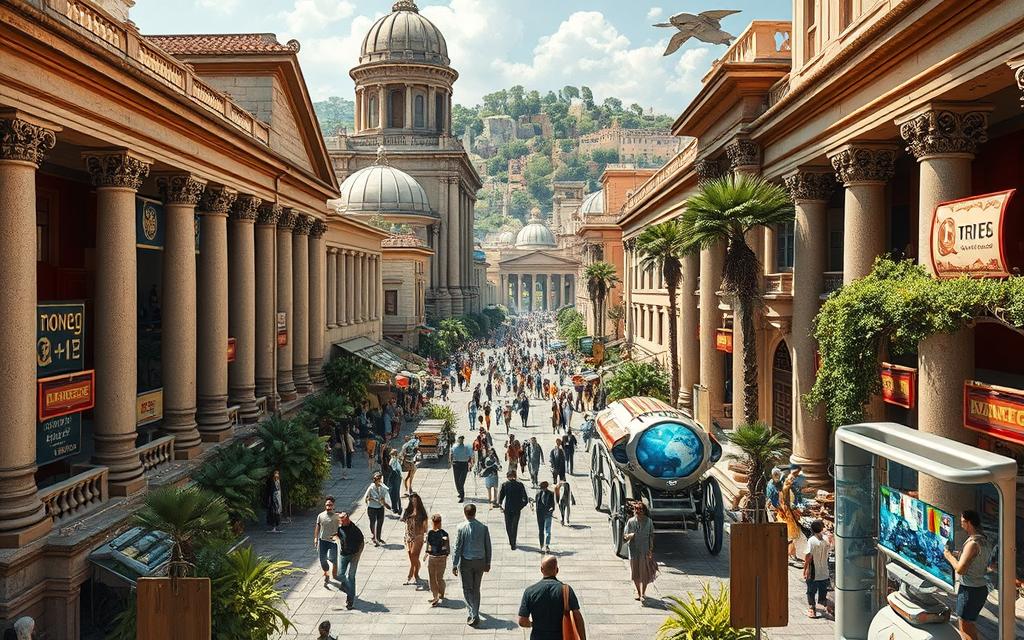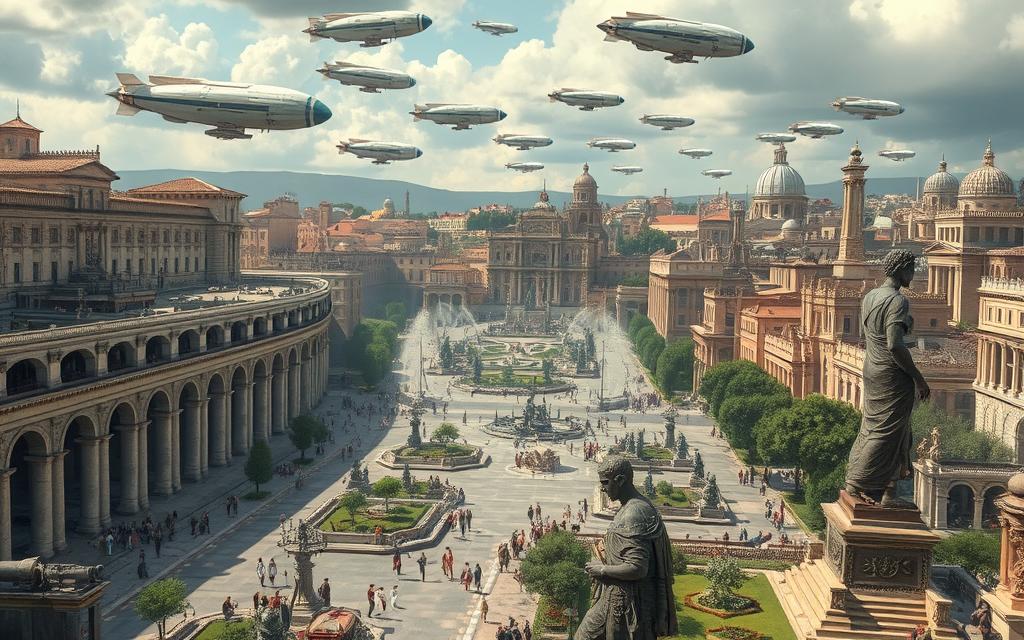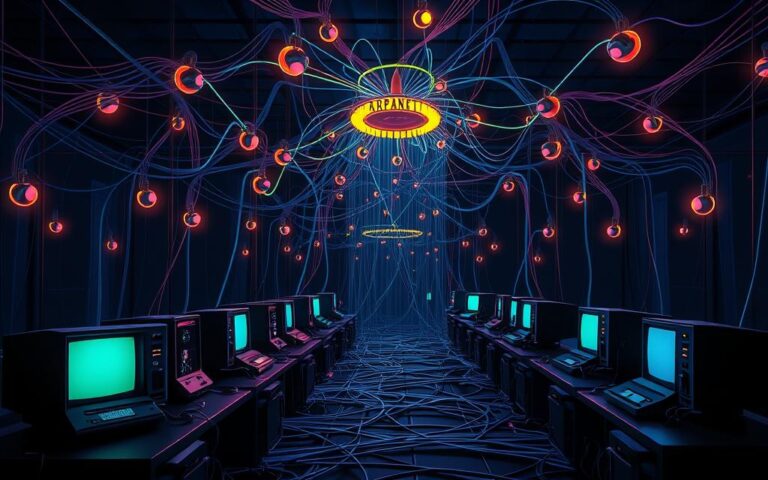How Technology Might Look if Rome Never Fell
Imagine a world where the Roman Empire still exists. It’s an interesting thought, right? This idea makes us think about how technology would have grown from the empire’s achievements. The Romans were known for their impressive buildings, well-planned cities, and many other advances. Their economy supported a growing population and higher incomes per person. This environment was perfect for new technologies to develop.
Roman history shows a big jump in how much they made and used from the 3rd century BCE. This peak happened during the 1st century BCE and CE. We wonder how Roman inventions and ways of doing things might have evolved if the empire had lasted longer. There were all the right conditions for new inventions. Without Rome’s fall, we might have seen a surge in technology long before the actual Industrial Revolution in England.
Roman engineering was ground-breaking. They made new building materials and designed aqueducts and roads that we still use ideas from today. The Romans’ work shows how ongoing advances in their technology could have led to more discoveries. Let’s explore this idea more. We’ll look into how history could have been different with Roman technology leading the way.
The Legacy of Roman Engineering and Technology
Roman engineering marks a key point in building and planning history. It shaped our environment significantly. The Roman Empire’s build and design standards influence us even now.
Innovations in Infrastructure
Roman engineers built vast networks of roads and aqueducts. Their roads used crushed stone, sand, and pavers in a clever design. The Aqua Appia aqueduct, started in 312 BCE, brought water and improved public health across the empire.
Advancements in Construction Materials
Roman concrete was a groundbreaking material. It allowed for huge, enduring structures. Their hydraulic mining showed how they expertly found and used materials like gold. This highlights their skill in construction.
Influence on Modern Urban Planning
Romans’ urban planning ideas still shape today’s cities. They used grid layouts and public spaces wisely. Their engineering legacy is seen in our focus on efficient infrastructure and smart planning.
Trade Routes and Economic Impact
The survival of the Roman Empire could have changed global trade routes a lot. It would have enhanced their economic impact through a vast network. These trade routes became channels for exchanging goods, ideas, and cultures, affecting future generations.
With their wide reach, the Romans initiated trade with different cultures. This action became a key feature of their economic strength.
Expansion of Trade Networks
Trade networks grew massively under the Roman Empire. They reached from Hadrian’s Wall to the Atlas Mountains. These networks moved goods like grain, wine, and oil from rural areas, especially when farming thrived.
As trade boomed, so did the wealth of the empire. This success set an example for future empires to follow these prosperous paths.
Colonial Powers and Global Trade Dynamics
If the Roman Empire had lasted longer, its impact on colonialism and the Americas would have been huge. It could have created a strong global trade setup. This setup would involve many nations and cultures.
Trade routes might have changed, including influences from Coptic Egypt and Byzantium. This would start a new era of economic exchanges.
Comparative Analysis with Other Civilisations
Comparing Roman trade practices with other civilisations shows different economic strategies. These strategies played a big part in their growth. By looking at Roman efficiency and infrastructure, scholars learn about their economic impact.
This comparison reveals how ancient empires interacted. It helps us understand modern trade and colonialism talks.
For more on how the Roman Empire’s economy worked, check out this detailed look at its economic impact. The Romans didn’t just connect their territories through trade routes. They also left a lasting mark on today’s economic practices.
what if rome never fell technology
Imagine a world where the Roman Empire never fell. The level of technological growth might have been amazing. This would mean more advancements in building, technology, and health. Romans already learned a lot from ancient cultures like Greece and Egypt. Their drive for innovation could have led to even greater discoveries.
Potential Technological Progression
In a thriving Roman Empire, technology could have advanced faster than in other places. Roman skills in building might have improved even more. They could have made stronger forts and better city facilities. Techniques for making roads better and water supply systems more advanced would have been possible. These improvements could come from the knowledge of other ancient cultures.
Greek and Egyptian Contributions
Knowledge from Greece and Egypt was very important for Rome’s technological growth. Greek philosophy helped in science and maths, while Egypt was great at engineering and health. Their ideas could lead to better water systems and medical practices. They might have even started using steam power early, leading to inventions before anyone else in Europe did in the 18th and 19th centuries.

The Social Structure and Knowledge Preservation
The Roman Empire saw a close link between social structure, education, and knowledge preservation. They set up schools and guilds, making learning a key aspect of life. This created a society where saving knowledge was very important.
Impact on Education and Knowledge Transfer
Roman education catered to all, from the elite to common folk. Their 44,000 miles of roads made sure ideas could travel across the empire. Guilds were crucial for vocational training and passing down knowledge. This focus on learning kept the social classes in order, letting the educated have more power.
Role of the Church in Technological Advancements
After the Roman Empire fell, the Church became very powerful. It backed education, setting up monastic schools. These schools saved many old texts and helped translate important works into Latin. This helped keep knowledge alive in medieval times. The Church didn’t just shape education but also pushed for new technologies, playing a big role in society’s progress.
| Aspect | Role in Social Structure | Impact on Knowledge Preservation |
|---|---|---|
| Education Systems | Promoted learning among various societal strata | Facilitated knowledge transfer across generations |
| Guilds | Provided vocational training | Ensured practical knowledge was passed down |
| The Church | Acted as a central authority | Preserved and translated classical texts |
| Road Infrastructure | Connected diverse regions | Supported cultural and educational exchanges |
Religious and Cultural Implications
The Roman Empire’s lasting influence would greatly affect Christianity and its religious meaning. If Rome had not fallen, we might not see the divisions that occurred in the medieval period. Christianity could have grown more uniformly, reducing the pagan impacts that influenced many practices later on.
Christianity’s Development without Decline
Had Rome remained stable, Christianity might have become a more unified faith throughout the empire. Such steadiness could lead to a solid theological base, with consistent beliefs and rituals. Without splits and conflicts, Christianity could have strengthened as a key part of Roman identity.
Interaction with Other Religions and Cultures
Rome’s ongoing spread into varied lands would have promoted a lively cultural exchange. Mixing with local customs and beliefs could create a diverse blend of religious practices. This way, Christianity and local spiritual traditions could merge, bringing together practices from the Gauls, Egyptians, and others.
| Aspect | Without the Fall of Rome | After the Fall of Rome |
|---|---|---|
| Christian Unity | Continued theological consistency | Fragmentation into diverse sects |
| Cultural Exchange | Rich blending with local religions | Isolation of different religious practices |
| Pagan Influences | Minimal influences on Christianity | Significant pagan elements in rituals |
| Religious Identity | Stronger Roman Christian identity | Diverse identities and local practices |
This situation would majorly influence Europe and the Mediterranean’s religious scene. It would affect how beliefs mingled and changed. These changes would lay a groundwork for future cultural and religious exchanges.
Conclusion
Thinking about the Roman Empire not falling offers deep insights. It shows how ancient historical influence impacts our society today. Advancements in engineering, technology, and city planning could have created a technological future we can hardly imagine, changing how we see everyday conveniences.
The empire’s creators, like the ones who made the aqueducts, show their focus on practical progress. With aqueducts reaching 500km for over five centuries, they highlight the importance of managing water and infrastructure. Their use of polished concrete and tunnels taught us how to be efficient and maintain structures, which helps engineers today.
Discussing the Roman Empire’s legacy shows how vital ancient tech was and makes us think about history’s role in today’s world. For more on what we can learn from ancient Rome, check out this article. Innovation today is just as crucial as back then, linking history to our tech-savvy world.
FAQ
What technological advancements might have occurred if the Roman Empire had not fallen?
If the Roman Empire had stayed, we could have seen faster progress in engineering, architecture, and medicine. This is because they would have built on the knowledge from Greece and Egypt. The Romans were known for improving infrastructure and construction techniques, which would have been enhanced by learning from other cultures.
How did Roman engineering influence modern infrastructure?
Roman engineering has hugely influenced today’s infrastructure through their building of aqueducts, roads, and bridges. These projects show us how to make structures that last and function well. These age-old principles are key in the development of our modern infrastructure.
In what ways would trade dynamics have changed with a continuing Roman Empire?
A lasting Roman Empire would have grown trade routes further, creating a wide-reaching trade system. This might have led to more efforts to explore and settle new lands, like the Americas. It would have also kept strong trade with regions like Coptic Egypt and Byzantium.
What impact would the Roman Empire’s survival have on knowledge preservation?
A successful Roman Empire would have likely developed a better educational system, kept alive by guilds and public institutions. This setup would have boosted the preservation of knowledge and encouraged learning. It would have made it easier to share technological ideas and innovations.
How might Christianity have developed differently without the fall of the Roman Empire?
Without the Empire’s fall, its impact on Christianity could have kept the religion more unified during the medieval period. Continuous communication might have helped maintain a consistent religious practice throughout the empire. This could have minimized pagan influences and supported a blend of beliefs.
What role did ancient philosophies play in potential technological progression?
Greek philosophical and scientific ideas, along with Egyptian innovations, could have boosted Roman tech progress. These ancient concepts might have sped up Rome’s technological advances, fostering a strong innovation culture.
What are some key elements of modern urban planning derived from Roman practices?
Today’s urban planning takes a lot from ancient Roman ideas, like the use of grid layouts, creating public spaces, and building efficient transport networks. These Roman planning methods are still central to how we design our cities, showing Rome’s lasting urban legacy.















